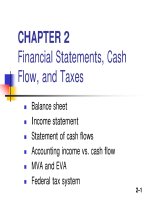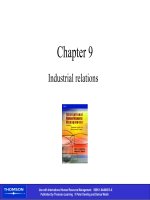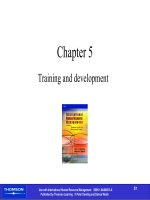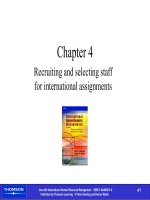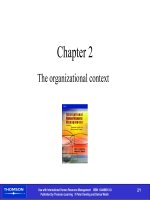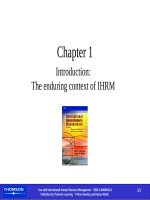International human resource management - Chapter 2 pptx
Bạn đang xem bản rút gọn của tài liệu. Xem và tải ngay bản đầy đủ của tài liệu tại đây (2.61 MB, 30 trang )
Use with International Human Resource Management ISBN 1-84480013-X
Published by Thomson Learning © Peter Dowling and Denice Welch
2/1
Chapter 2
The organizational context
Use with International Human Resource Management ISBN 1-84480013-X
Published by Thomson Learning © Peter Dowling and Denice Welch
2/2
Chapter objectives
•
structural responses to international growth
•
control and coordination mechanisms
(cont.)
In this chapter, we examine how international growth places
demands on management, and the factors that impact on how
managers of internationalizing firms responds to these
challenges. We start with the premise that the human resource
(HR) function does not operate in a vacuum, and that HR
activities are determined by, and influence, organisational
factors. We cover the following areas:
Use with International Human Resource Management ISBN 1-84480013-X
Published by Thomson Learning © Peter Dowling and Denice Welch
2/3
Chapter objectives (cont.)
•
mode of operation used in various international markets
•
effect of responses on human resource management
approaches and activities.
It builds upon material covered in Chapter 1 to provide a
meaningful global and organizational context for drawing out
the international dimension of human resource management –
the central theme of this book.
Use with International Human Resource Management ISBN 1-84480013-X
Published by Thomson Learning © Peter Dowling and Denice Welch
2/4
Figure 2-1: Management demands of international growth
Use with International Human Resource Management ISBN 1-84480013-X
Published by Thomson Learning © Peter Dowling and Denice Welch
2/5
The path to global status
•
Causes structural responses, due to:
–
Strain imposed by growth and geographical
spread
–
Need for improved coordination and control
across business units
–
The constraints imposed by host-government
regulations on ownership and equity
•
Evolution path common but not normative
Use with International Human Resource Management ISBN 1-84480013-X
Published by Thomson Learning © Peter Dowling and Denice Welch
2/6
Figure 2-2: Stages of internationalization
Use with International Human Resource Management ISBN 1-84480013-X
Published by Thomson Learning © Peter Dowling and Denice Welch
2/7
Stages of internationalization:
Exporting
•
Typically the initial stage of international
operations
–
Usually handled by an intermediary (foreign
agent or distributor)
–
Role of HR department unclear at this stage
Use with International Human Resource Management ISBN 1-84480013-X
Published by Thomson Learning © Peter Dowling and Denice Welch
2/8
Figure 2-3: Export department
Use with International Human Resource Management ISBN 1-84480013-X
Published by Thomson Learning © Peter Dowling and Denice Welch
2/9
Sales subsidiary
•
Replacing foreign agents/distributors with own
through sales or branch offices/subsidiaries
•
May be prompted by:
–
Problems with foreign agents
–
More confidence in international activities
–
Desire for greater control
–
Give greater support to exporting activities
•
PCNs may be selected, leading to some HR
involvement
Use with International Human Resource Management ISBN 1-84480013-X
Published by Thomson Learning © Peter Dowling and Denice Welch
2/10
Figure 2-4: Sales subsidiary
Use with International Human Resource Management ISBN 1-84480013-X
Published by Thomson Learning © Peter Dowling and Denice Welch
2/11
International division
•
Creation of a separate division in which all
international activities are grouped
•
Resembles ‘miniature replica’ of domestic
organization
•
Subsidiary managers report to head of
international division
•
Objectives regarding foreign activities may
determine approach to staffing of key positions
–
Expatriate management role of corporate HR
Use with International Human Resource Management ISBN 1-84480013-X
Published by Thomson Learning © Peter Dowling and Denice Welch
2/12
Figure 2-5: International division
Use with International Human Resource Management ISBN 1-84480013-X
Published by Thomson Learning © Peter Dowling and Denice Welch
2/13
Global product/area division
•
Strain of sheer size may prompt structural
change to either of these global approaches
•
Choice typically influenced by:
–
The extent to which key decisions are to be
made at the parent country headquarters or at
the subsidiary units (centralization versus
decentralization)
–
Type or form of control exerted by parent over
subsidiary
Use with International Human Resource Management ISBN 1-84480013-X
Published by Thomson Learning © Peter Dowling and Denice Welch
2/14
Figure 2-6a: Global product division Figure 2-6b: Global area division
Use with International Human Resource Management ISBN 1-84480013-X
Published by Thomson Learning © Peter Dowling and Denice Welch
2/15
The matrix
•
An attempt to integrate operations across
more than one dimension
•
Violates Fayol’s principle of unity of
command
•
Considered to bring into the management
system a philosophy of matching the
structure to the decision-making process
Use with International Human Resource Management ISBN 1-84480013-X
Published by Thomson Learning © Peter Dowling and Denice Welch
2/16
Figure 2-7: The matrix
Use with International Human Resource Management ISBN 1-84480013-X
Published by Thomson Learning © Peter Dowling and Denice Welch
2/17
Problems with the Matrix
Bartlett and Ghoshal
•
Dual reporting
•
Proliferation of
communication
channels
•
Overlapping
responsibilities
•
Barriers of distance,
language, time and
culture
Leads to conflict and
confusion
Creates informational logjams
Produce turf battles and loss of
accountability
Make it virtually impossible to
resolve conflicts and clarify
confusion
Use with International Human Resource Management ISBN 1-84480013-X
Published by Thomson Learning © Peter Dowling and Denice Welch
2/18
Beyond the matrix
•
Less hierarchical structural forms
–
Heterarchy
–
Transnational
–
Networked firm
Use with International Human Resource Management ISBN 1-84480013-X
Published by Thomson Learning © Peter Dowling and Denice Welch
2/19
Figure 2-8: The networked organization
Use with International Human Resource Management ISBN 1-84480013-X
Published by Thomson Learning © Peter Dowling and Denice Welch
2/20
Figure 2-9: US, European and Japanese structural changes
Use with International Human Resource Management ISBN 1-84480013-X
Published by Thomson Learning © Peter Dowling and Denice Welch
2/21
Control mechanisms
“Globalization brings considerable challenges
which are often under-estimated….
Every morning when I wake I think about the
challenges of coordinating our operations in
many different countries”
Quote by Accor CEO
Use with International Human Resource Management ISBN 1-84480013-X
Published by Thomson Learning © Peter Dowling and Denice Welch
2/22
Figure 2-10: Control mechanisms
Use with International Human Resource Management ISBN 1-84480013-X
Published by Thomson Learning © Peter Dowling and Denice Welch
2/23
Mode of operation and HRM
•
Not just subsidiary operations
•
Firms may also adopt co ntractual modes
–
Licensing
–
Franchising
–
Management contracts
–
Projects
•
And/or coo perativ e modes (such as joint
ventures)
Use with International Human Resource Management ISBN 1-84480013-X
Published by Thomson Learning © Peter Dowling and Denice Welch
2/24
Figure 2-11: Linking operation mode and HRM
Use with International Human Resource Management ISBN 1-84480013-X
Published by Thomson Learning © Peter Dowling and Denice Welch
2/25
Interfirm linkages
•
Alliance (strategic alliance, cooperative
venture, collaborative venture or corporate
linkage)
•
A form of business relationship that:
–
Involves some measure on interfirm integration
–
Stops short of a full merger or acquisition
